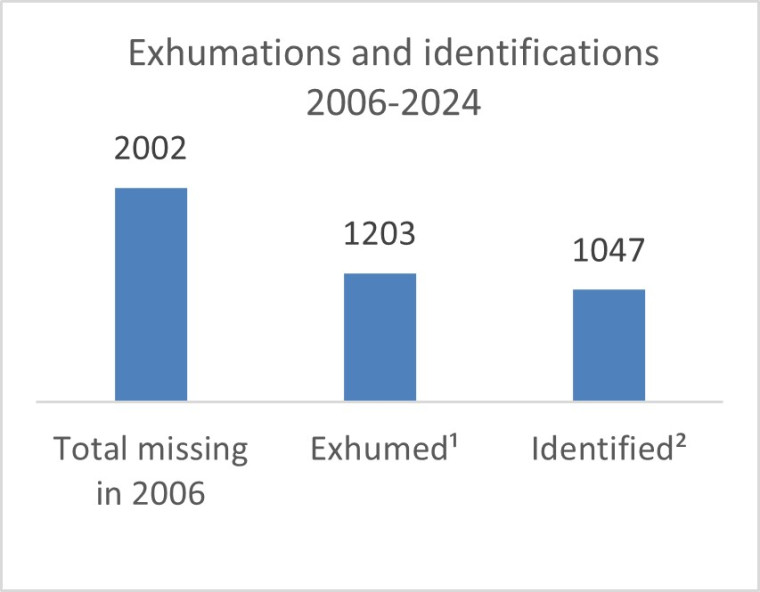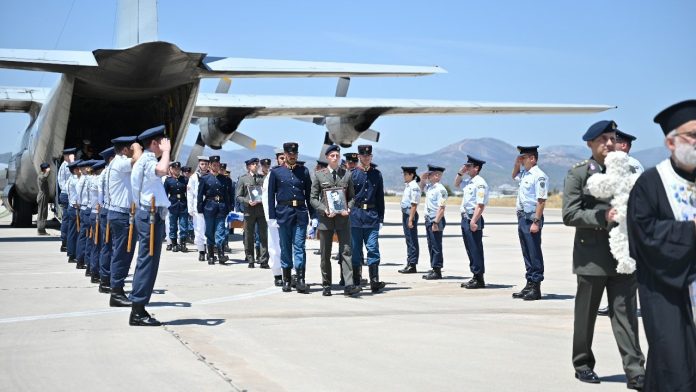The remains of 15 newly identified Greek soldiers of the Hellenic Force of Cyprus (ELDYK) have been reclaimed by their families, 50 years after the 1974 Turkish invasion of the island, 36 percent of which has since been occupied by the Turkish Army and ethnically cleansed of its Greek-Cypriot population.
The soldiers had been considered missing as their bodies were never recovered in the aftermath of two phases of the Turkish invasion, the “Attila 1″ and “Attila 2” operations on July 20 and August 14, 1974, respectively.
ELDYK is a Greek battalion permanently stationed in Cyprus since 1960 and the only Greek military force that fought alongside the Cypriot National Guard against the invading Turkish forces, alongside 278 airborne troops that arrived on the island on July 22, 1974. The Greek military junta that had toppled Cyprus’s democratically elected leader, Archbishop Makarios, had installed its own puppet government to declare Union (Enosis) with Greece but did not declare war on Turkey when the latter exploited the coup to act upon its long-term strategic goals vis-a-vis Cyprus.
Nine ELDYK soldiers were repatriated to Greece where they were received earlier today by the Greek Defense Minister, Nikos Dendias, the chiefs of the Hellenic National Defense General Staff (HNDSG) and the Cypriot Ambassador at Elefsina Air Base, home of the 112th Combat Wing of the Hellenic Air Force. Their families will then receive the remains in their hometowns and villages across Greece.
?? ??????? ?????????? ??? ?????????? ??? ???????? ??????? ??????, ?????????? ???? ?????????? ???? ?????????, ?? ??????? ??? ?????????? ???? ??? ??? ??????? ??? ????????? ????, ?? ??????? 9 ??????? ???????????? ??? ?????? ?? 1974, ????????????? ??? ??? ?/??? ???????????? ?.… pic.twitter.com/Sc83jZCd3W
— Nikos Dendias (@NikosDendias) May 31, 2024
Before the repatriation, a funeral with full military honors was held at Cyprus’s military cemetery in Tymbos Makedonitissas for six of the Greek soldiers whose families decided that they should be buried on the island. The President of the Republic of Cyprus, Nikos Christodoulides, and Greece’s Chief of the HNDGS, General Dimitris Houpis, attended the ceremony. The President delivered a eulogy to honor the fallen soldiers:
“They arrived from Greece to strengthen the defence of our territories, to safeguard the sovereignty and independence of our homeland, to counter Attila’s hordes, to join their brothers in Cyprus, as in every other shared national imperative of history.”
“It is a fact that every time we hold funeral services for our Greek Cypriot and Greek Cypriot brothers and sisters, who were considered missing and whose remains have been identified even after 50-60 years, the events of the brutal Turkish invasion that black summer of 1974 are revived and come to life. Today, here in this holy place, paying the proper tribute to our heroic Greek brothers, honoring them and their families for their contribution to our homeland, for their sacrifice, for the blood they gave to our homeland, the battlefields, the conditions of war, the looting, the bombardments, the past becomes present again and enlarges the memory.”
Cyprus’s Missing: 50 Years On
Cyprus’s missing persons in the aftermath of the illegal Turkish invasion of Cyprus in 1974 include Greek soldiers of ELDYK, Greek Cypriots serving in Cyprus’s national guard, the police, and civilians, among which are 36 children, of which only 20 have been discovered and identified to this date, the youngest being 6 months and the oldest 17 years old.
Joint efforts between the Republic of Cyprus and the Turkish Cypriot community to locate and identify missing persons officially began in 1981 with the establishment of the Committee on Missing Persons in Cyprus (CMP) with the support of the United Nations. The inter-communal Committee’s mission is not to identify “the cause of death or attribute responsibility for the death of missing persons” from either side but to pursue a humanitarian objective for all Cypriots “bringing closure to thousands of affected families through the return of the remains of their missing relatives” killed during the inter-communal conflict of 1963-64 or the Turkish invasion of 1974.
A total of 2,002 persons from both the Greek and Turkish Cypriot communities (492 Turkish Cypriots and 1,510 Greek Cypriots) have been registered as missing by the Committee. Since 1981, the remains of 1,033 have been identified and returned to their families.
The Committee’s work was for at least two decades effectively roadblocked by Turkey and the Turkish Cypriot leadership in the occupied north, with inter-communal cooperation, mutual exchange of information and exhumations slowly beginning in earnest in 1998. US pressure and the passage of an Act of Congress in 1994 calling upon the President to “undertake, in cooperation with appropriate international organizations or nongovernmental organizations, a thorough investigation of the whereabouts of the United States citizens who have been missing from Cyprus since 1974” proved decisive in kick-starting the first investigation for a missing person in Cyprus.
The American efforts succeeded in finding the remains of 17-year-old Andreas Kassapis, an American citizen of Greek-Cypriot heritage, close to the Turkish-occupied village of Assia. This marked the first time that a missing person had been exhumed and identified using a forensic DNA method, paving the way for future investigations. Nevertheless, despite a meeting between the Cypriot President and the Turkish minority leader, Rauf Denktash where they both seemingly agreed to proceed with exhumations across the island, the government of the Republic of Cyprus was the only one to unilaterally implement the agreement until Turkey conceded to cooperating within the framework of the CMP in June 2004. The concession was forced upon Ankara in light of its European Union accession negotiations at the time.


